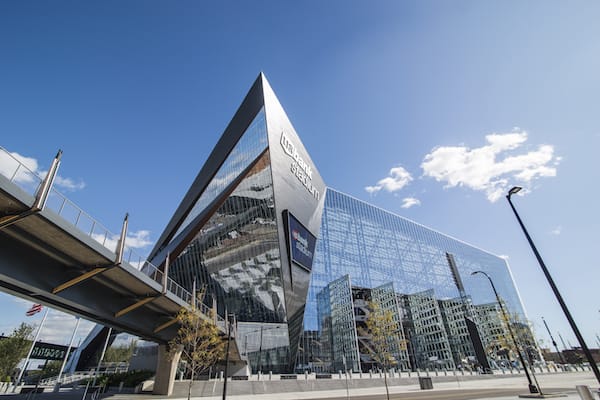U.S. Bank Stadium, the largest public works project in Minnesota history, is not just a multipurpose stadium in Minneapolis—it’s a work of art. Built on the site of the former Metrodome, the $1.1 billion stadium is nearly twice the size as the National Football League’s Minnesota Vikings’ old home, and is praised not only for its unique architecture but also for its commitment to sustainability.
U.S. Bank Stadium opened ahead of schedule in July 2016, after a two-and-one-half year construction period. More than 8,000 workers committed upwards of 4 million hours
to design and build the 1,750,000-sq.-ft. stadium.
 “At work behind the scenes at U.S. Bank Stadium are Bell & Gossett pumps,” said James Nolan, Market Development Manager for Xylem AWS. “We are proud to not only enhance the fan experience by satisfying the unique heating and cooling needs at this spectacular venue, but also help the stadium meet its energy conservation goals.”
“At work behind the scenes at U.S. Bank Stadium are Bell & Gossett pumps,” said James Nolan, Market Development Manager for Xylem AWS. “We are proud to not only enhance the fan experience by satisfying the unique heating and cooling needs at this spectacular venue, but also help the stadium meet its energy conservation goals.”
Bell & Gossett pumps play a vital role in rooftop snow removal …
The extreme climate of Minnesota—averaging 54 inches of snow per year—influenced the design of U.S. Bank Stadium. The roof of the facility resembles an A-framed ship so it is able to shed snow and ice efficiently, preventing buildup on the roof. Large volumes of snow accumulation caused ongoing problems at the Metrodome, resulting in the roof collapsing five times.
A Bell & Gossett Technoforce booster package provides the 400 gallons of hot water per minute that are used to hose down the snow- filled roof, sending melted snow down concrete gutters along the side of the stadium. The 6-foot- wide and 10-foot-deep gutters, which contain plastic tubes with glycol, carry the melted snow through the stadium’s storm-water control system and down to the ground where it is drained into the city sewer.
The Bell & Gossett Technoforce booster package is installed seven stories up on the top floor of the stadium and is not part of the stadium’s domestic hot water system, which is very rare. Typically, snow-melt systems are installed at the ground level, but U.S. Bank Stadium’s roof-melting system is the first of its kind.
… And drive the stadium’s water system
A Bell & Gossett Technoforce XLS Booster Package supplies all of the water—2,000 gallons per minute—to U.S. Bank Stadium. This includes providing water to the 979 bathroom stalls in the facility.
The booster package, which is installed in the stadium’s basement, contains four Bell & Gossett end suction pumps — three large pumps and one small pump. While only one pump works to send water throughout the building at 1,200 GPM at a time, all four pumps were designed to work with the 75HP variable frequency drives (VFDs) installed
in the water system to ensure optimal efficiency. A VFD- based booster pump system is advantageous in a high- rise structure because it can maintain more precise control over a wider range of the pumps’ ow rates while reducing energy consumption and pump wear.
Because the stadium is so large and water usage is drastically different during the week versus on game days, specifying pumps to efficiently circulate water throughout the facility was a challenge. The stadium was originally designed with three large Bell & Gossett end-suction pumps, but to keep operational costs down, the mechanical contractor speci ed a small Bell & Gossett jockey pump to power the water system when the stadium isn’t full of cheering fans, which is 95% of the time. On event days, three large Bell & Gossett pumps alternate pumping water throughout the building.
The redesign of the water system to include a small jockey pump improves efficiency and reduces energy costs. The jockey pump saves an average of $8,000 to $10,000 annually on energy.
To make sure the water system was fully operational before the stadium opened, hundreds of workers and volunteers participated in a Super Flush test. During the test, everyone simultaneously flushed all toilets and urinals and turned on all sinks in the stadium for about 30 minutes. Bell & Gossett pumps successfully handled the Super Flush.
… And power an HVAC system, ensuring fan comfort
With seating for up to 70,000, U.S. Bank Stadium offers more than 18 different styles of seating, including its Touchdown Suites, or luxury seating closer to the field than any other stadium in the NFL. The first row of seats is just 41 feet away from the sideline, and the field seats get fans even closer to the action at 25 feet.
The portion of the HVAC system that runs on the Bell & Gossett VSX Series pumps was prefabricated on a skid before it was installed. Prefabricating this section was advantageous because it enabled the skid to be built in a controlled environment while contractors worked on constructing other portions of the building to meet the scheduling demands of the project. The size of the VSX pumps enabled the skid to be smaller, reducing installation time.
“Because of their ease of installation and maintenance, the VSX pumps were the best choice for U.S. Bank Stadium’s HVAC system,” said Jim Burns, Vice President at Mulcahy Co. in Eagan, Minnesota, a B&G representative. “The pumps t seamlessly into the piping, and, because they’re Bell & Gossett, we know they’ll withstand the heating and cooling demands of the building for decades to come.”
U.S. Bank Stadium will host the 2018 Super Bowl, the NCAA basketball Final Four in 2019 and a wide array of sporting, cultural and entertainment events year-round. No matter what the use—or the weather — B&G products will be working efficiently and seamlessly behind the scenes to enhance environmental sustainability and the fan experience.




Join the conversation: